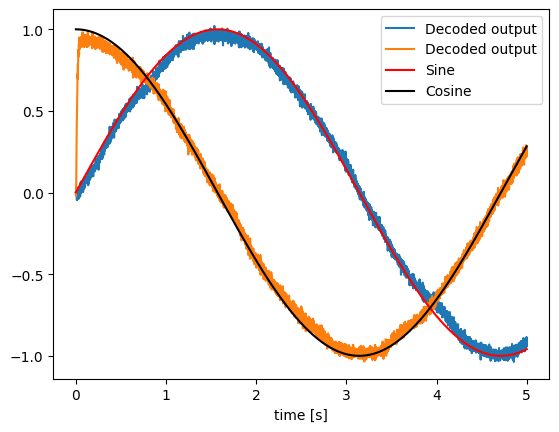Note
This documentation is for a development version. Click here for the latest stable release (v4.0.0).
2-dimensional representation¶
Ensembles of neurons represent information. In Nengo, we represent that information with real-valued vectors – lists of numbers. In this example, we will represent a two-dimensional vector with a single ensemble of leaky integrate-and-fire neurons.
Step 1: Create the network¶
Our model consists of a single ensemble, which we will call Neurons. It will represent a two-dimensional signal.
[1]:
%matplotlib inline
import matplotlib.pyplot as plt
import numpy as np
import nengo
model = nengo.Network(label="2D Representation")
with model:
# Our ensemble consists of 100 leaky integrate-and-fire neurons,
# and represents a 2-dimensional signal
neurons = nengo.Ensemble(100, dimensions=2)
Step 2: Provide input to the model¶
The signal that an ensemble represents varies over time. We will use a simple sine and cosine wave as examples of continuously changing signals.
[2]:
with model:
# Create input nodes representing the sine and cosine
sin = nengo.Node(output=np.sin)
cos = nengo.Node(output=np.cos)
Step 3: Connect the input to the ensemble¶
[3]:
with model:
# The indices in neurons define which dimension the input will project to
nengo.Connection(sin, neurons[0])
nengo.Connection(cos, neurons[1])
Step 4: Probe outputs¶
Anything that is probed will collect the data it produces over time, allowing us to analyze and visualize it later. Let’s collect all the data produced.
[4]:
with model:
sin_probe = nengo.Probe(sin, "output")
cos_probe = nengo.Probe(cos, "output")
neurons_probe = nengo.Probe(neurons, "decoded_output", synapse=0.01)
Step 5: Run the model¶
In order to run the model, we have to create a simulator. Then, we can run that simulator over and over again without affecting the original model.
[5]:
with nengo.Simulator(model) as sim:
sim.run(5)
[6]:
# Plot the decoded output of the ensemble
plt.figure()
plt.plot(sim.trange(), sim.data[neurons_probe], label="Decoded output")
plt.plot(sim.trange(), sim.data[sin_probe], "r", label="Sine")
plt.plot(sim.trange(), sim.data[cos_probe], "k", label="Cosine")
plt.legend()
plt.xlabel("time [s]")
[6]:
Text(0.5, 0, 'time [s]')
